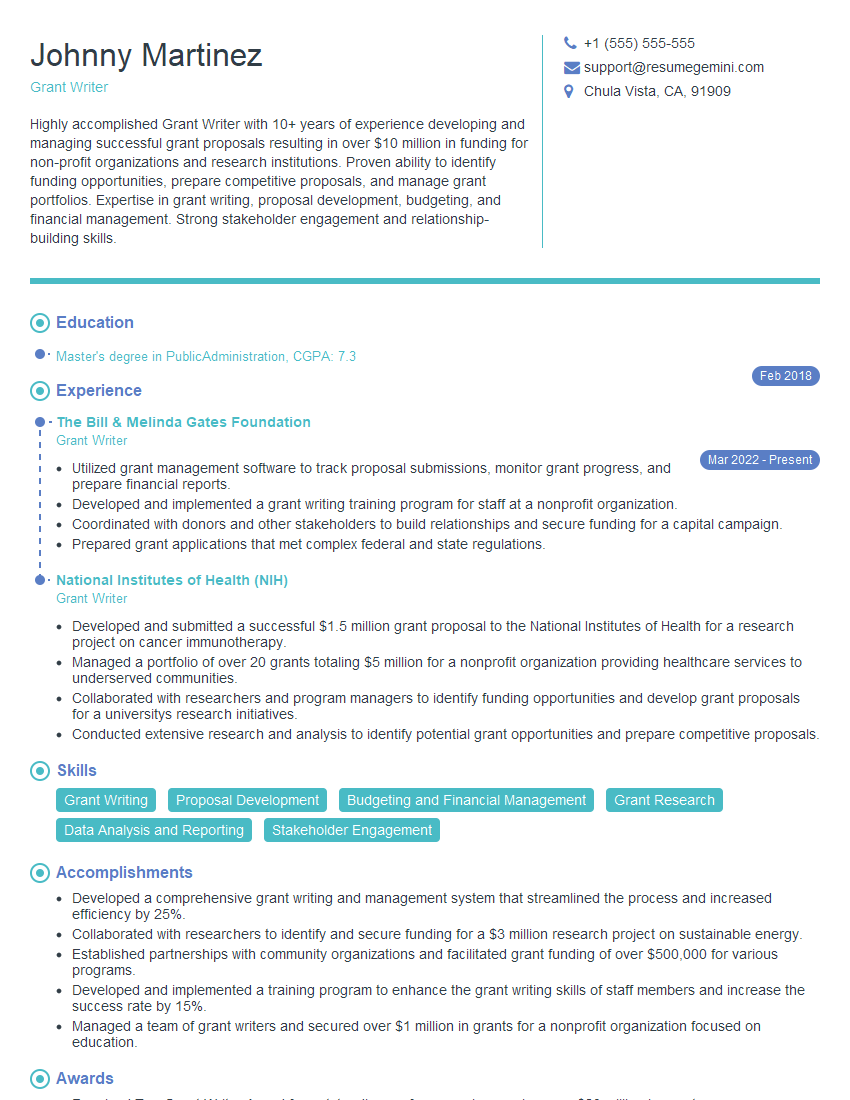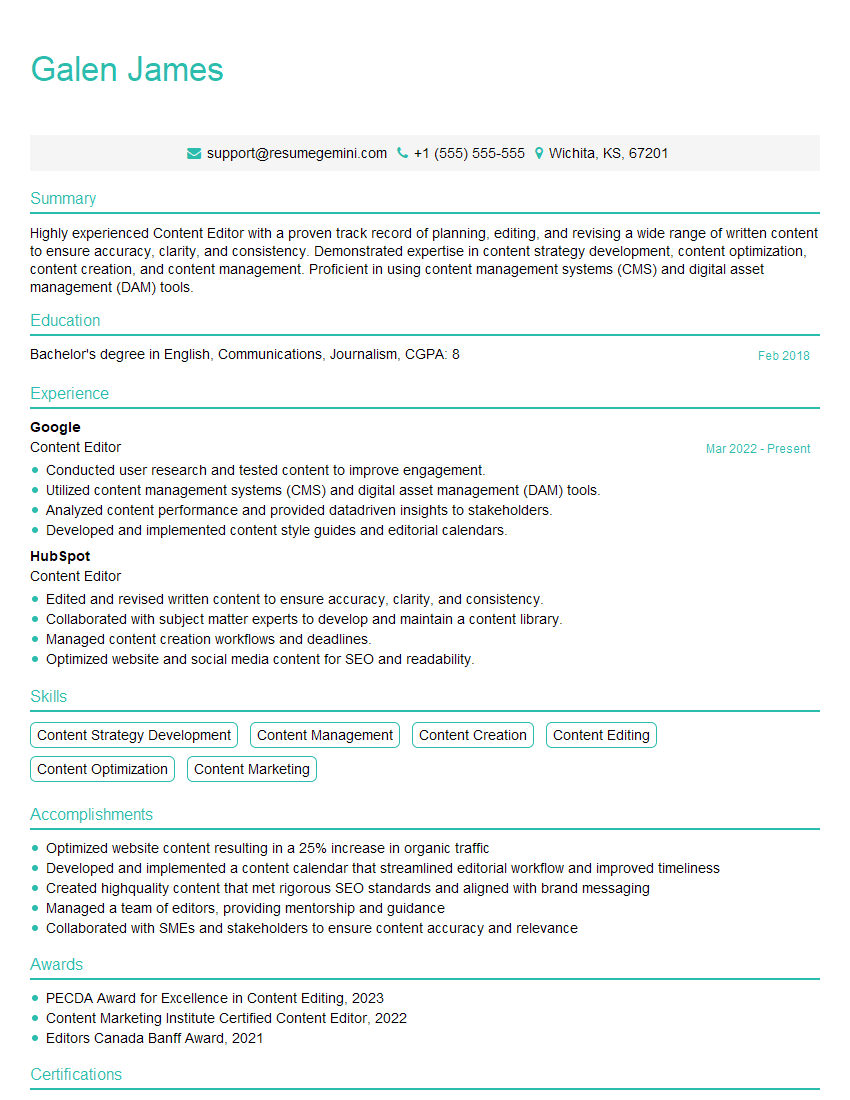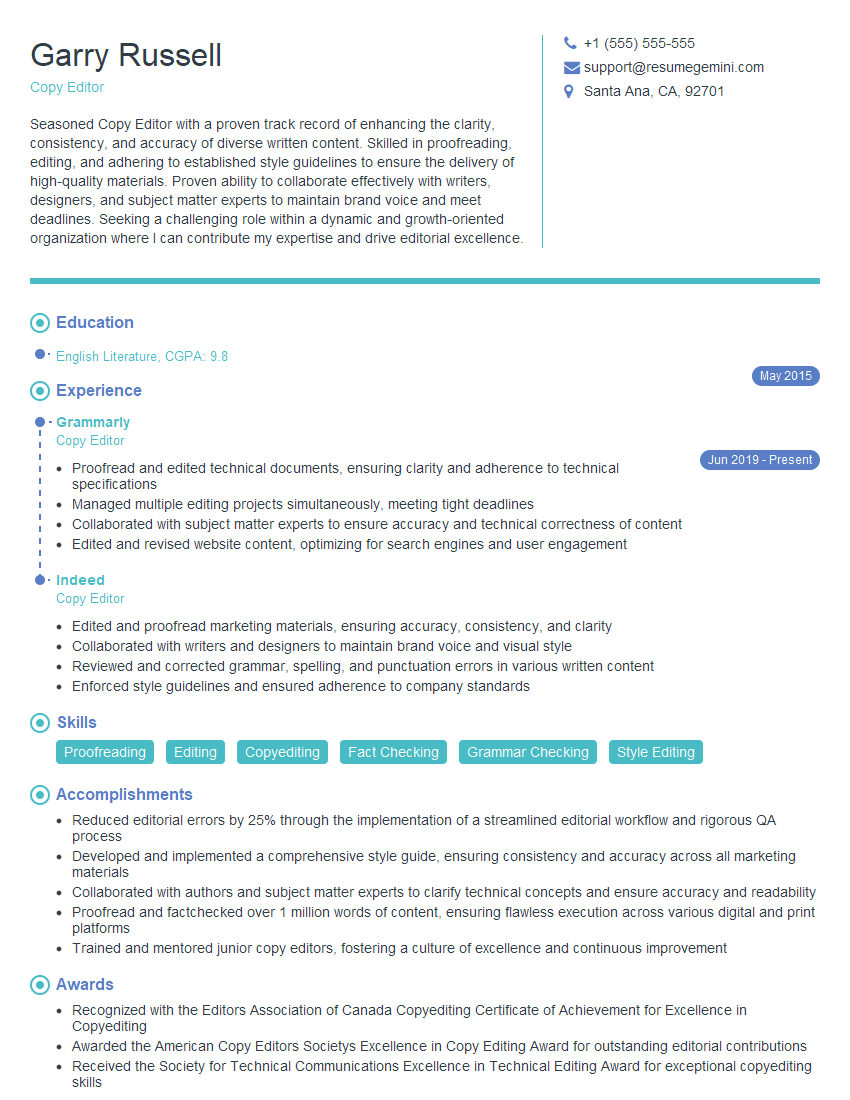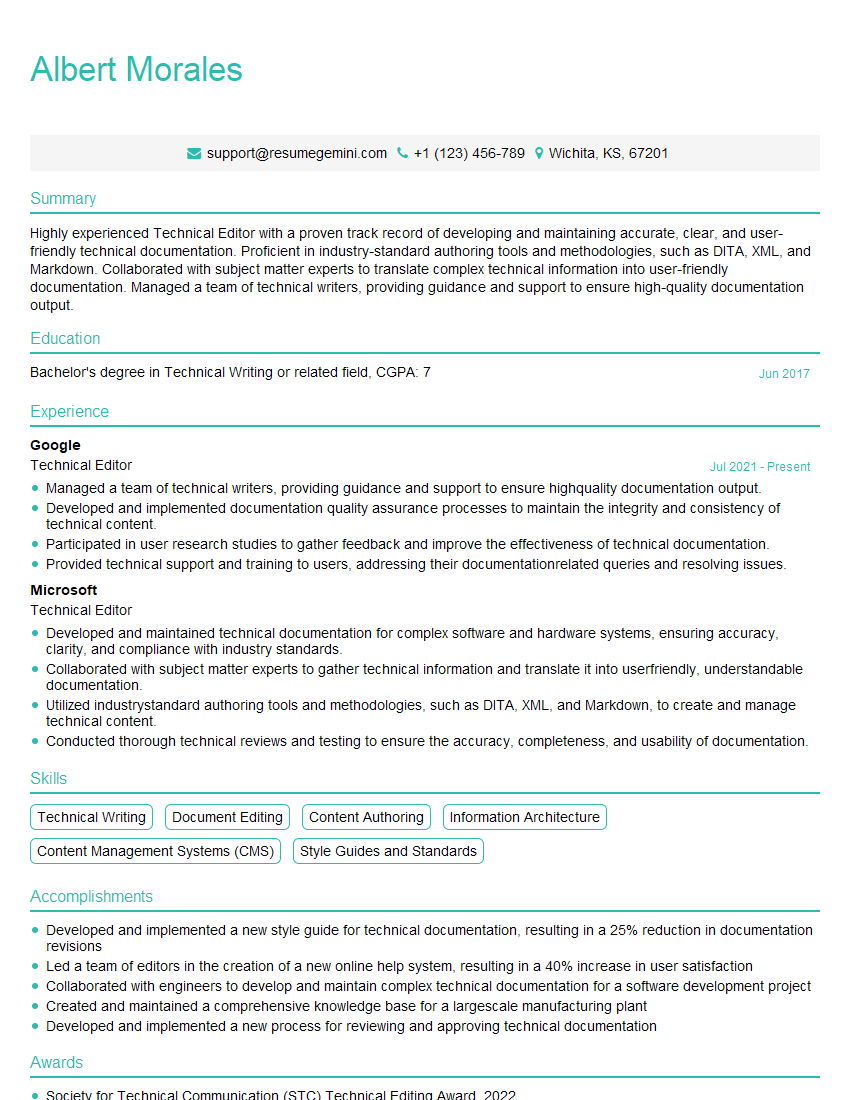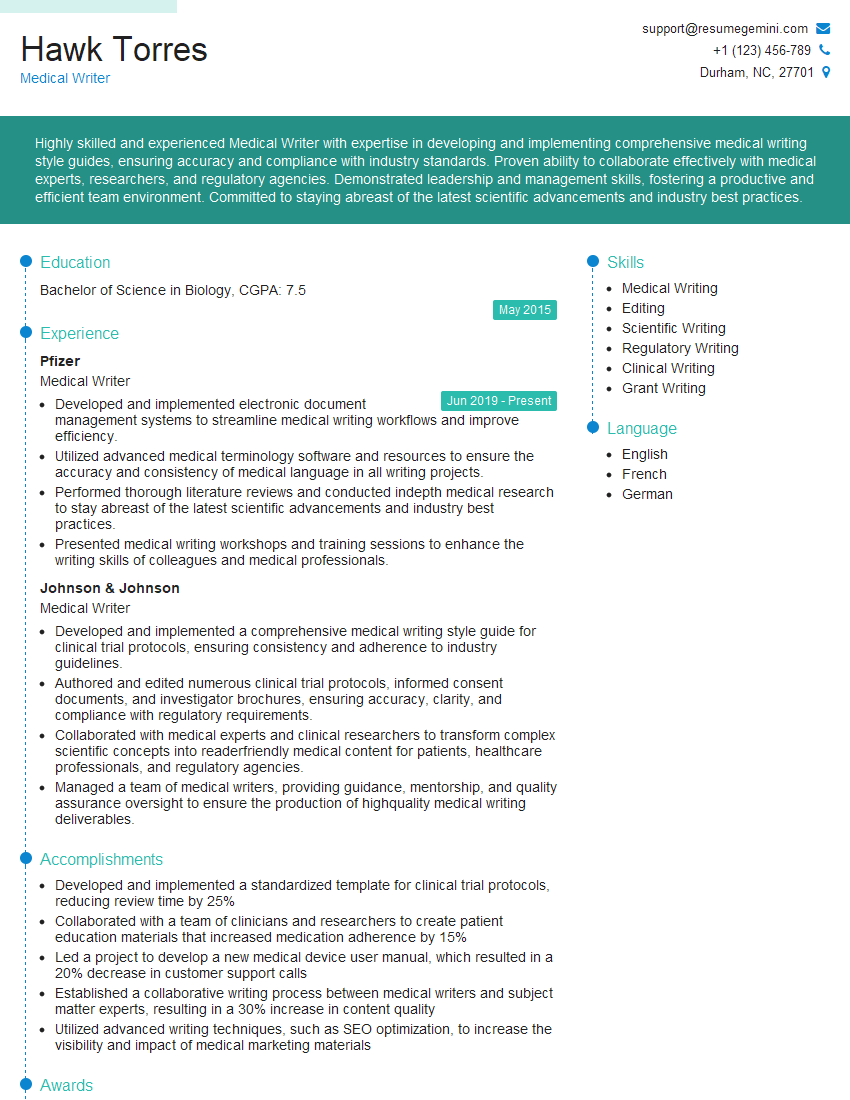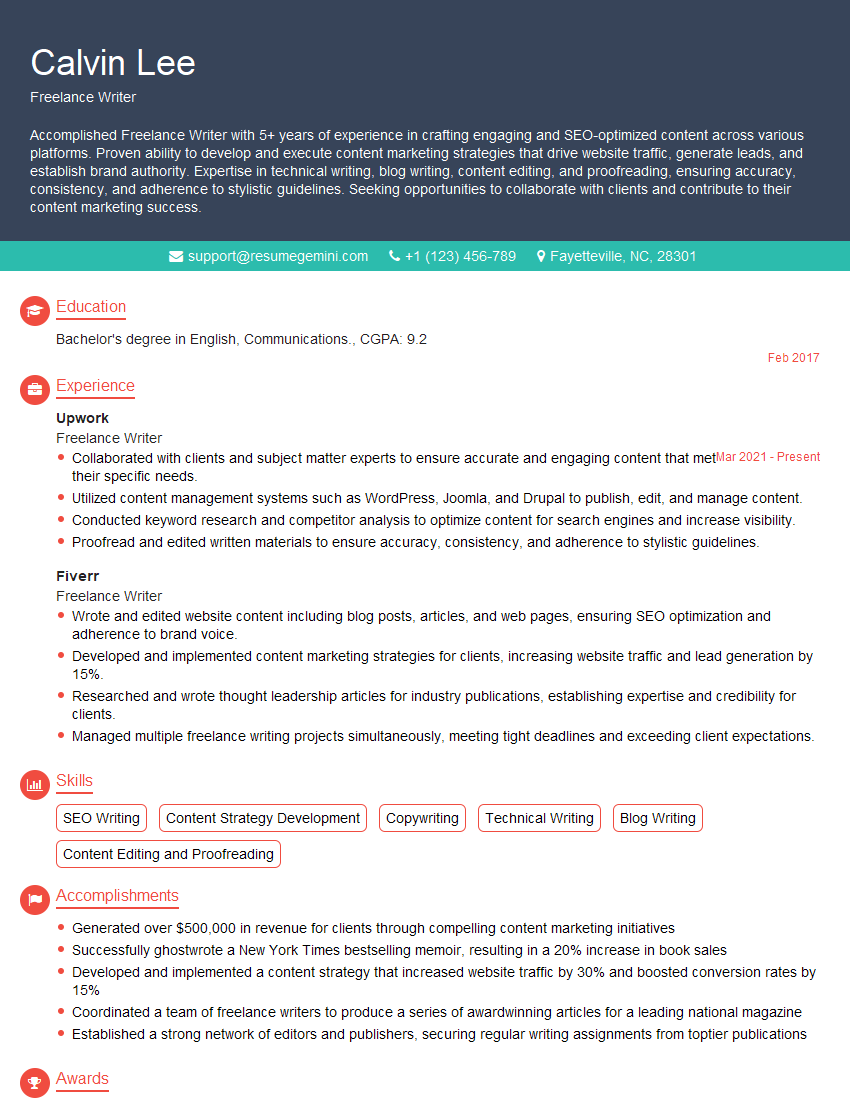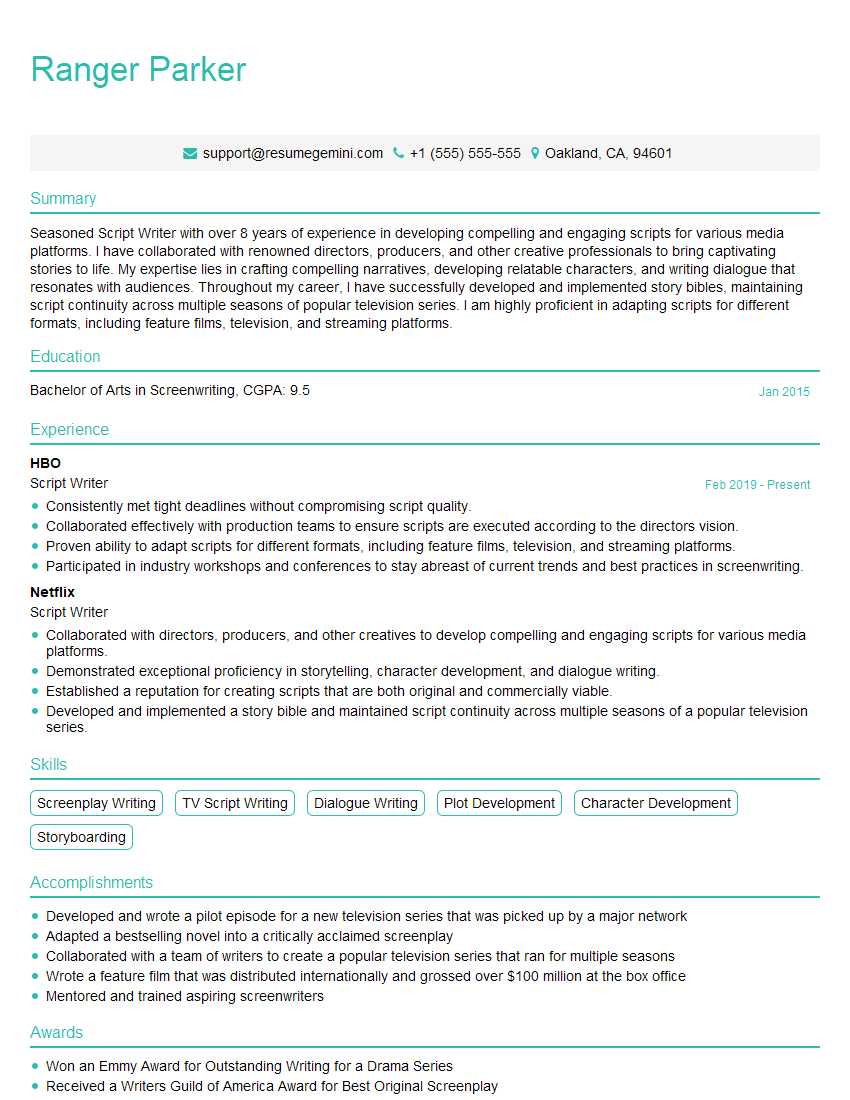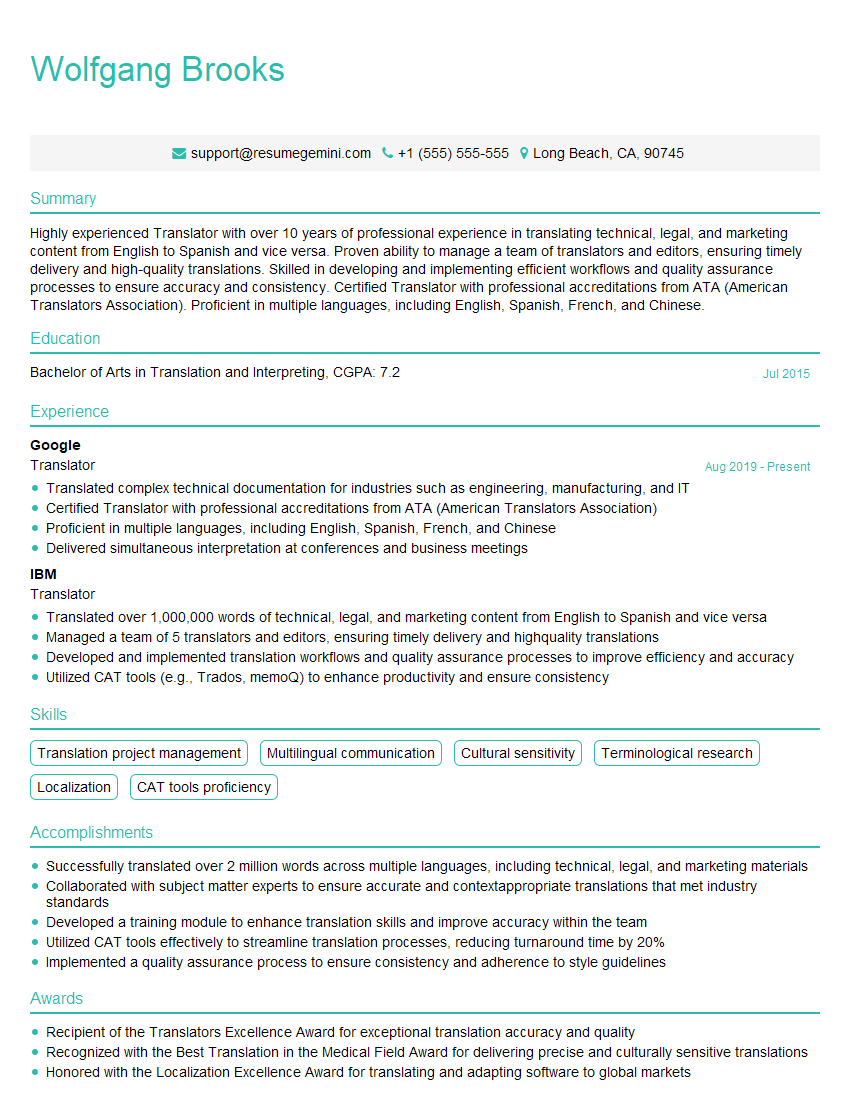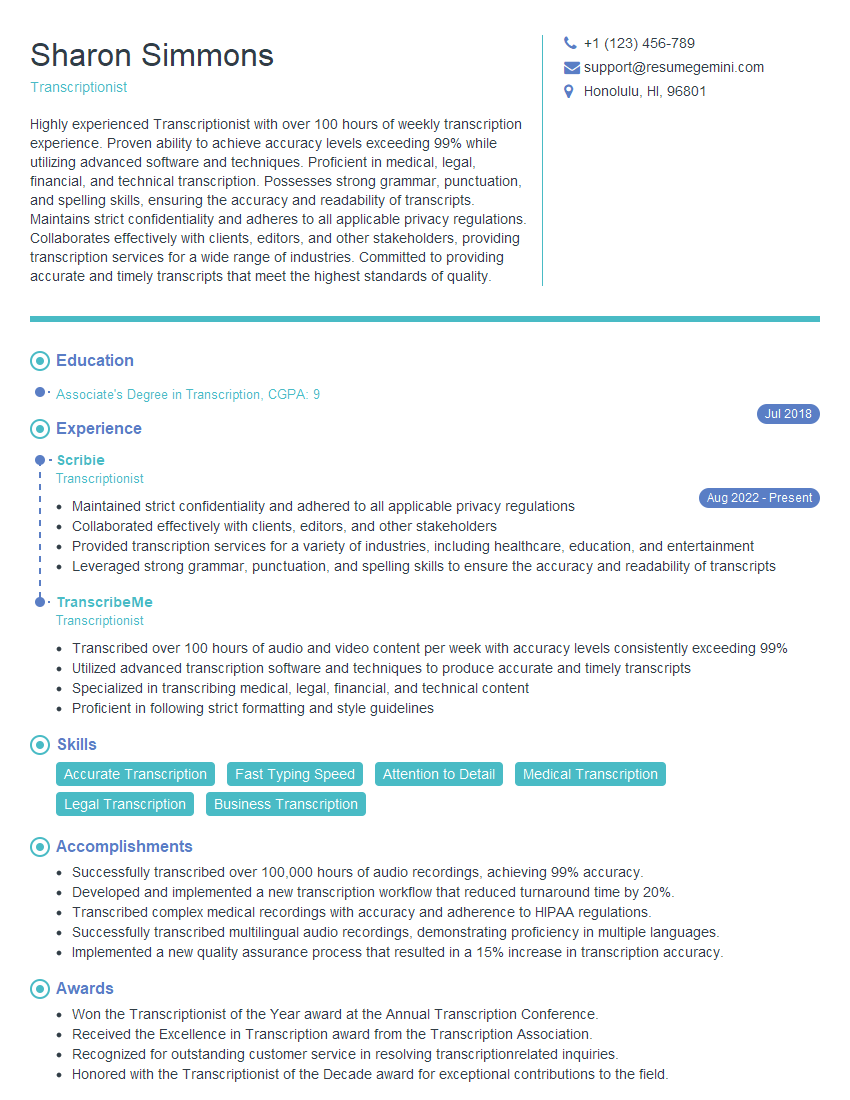Every successful interview starts with knowing what to expect. In this blog, we’ll take you through the top Freelance Writing and Editing interview questions, breaking them down with expert tips to help you deliver impactful answers. Step into your next interview fully prepared and ready to succeed.
Questions Asked in Freelance Writing and Editing Interview
Q 1. What experience do you have with AP style and Chicago style guides?
AP style and Chicago style are two prominent style guides used in writing and editing. AP (Associated Press) style is widely used in journalism and prioritizes brevity, clarity, and objectivity. Chicago style, on the other hand, is more comprehensive and commonly employed in academic writing and books. My experience encompasses extensive use of both. I’ve worked on numerous projects requiring AP style, such as news articles and press releases, where concise language and adherence to specific formatting rules are crucial. For example, I’ve meticulously formatted dates (e.g., Month Day, Year), ensured consistent capitalization, and properly cited sources according to AP guidelines. Similarly, I have experience with Chicago style in projects like academic papers and book manuscripts, paying close attention to its detailed rules on footnote/endnote formatting, bibliography creation, and punctuation.
For instance, I recently edited a historical biography that required meticulous adherence to Chicago’s citation format. This included correctly formatting bibliographic entries, ensuring consistency in footnote placement, and verifying the accuracy of every source cited. This detailed approach is essential for maintaining academic integrity and credibility.
Q 2. Describe your process for editing a long-form article.
Editing a long-form article is a multi-stage process that requires careful attention to detail and a systematic approach. My process typically involves several key steps:
- First Read: I perform a comprehensive first read focusing on the overall flow, argument, and structure of the article. I look for any gaps in logic, inconsistencies in tone, or areas needing further development.
- Fact-Checking: Next, I meticulously fact-check all claims, statistics, and citations. This involves verifying information from multiple reliable sources to ensure accuracy and avoid misinformation. I utilize a combination of online databases, academic journals, and primary sources, depending on the article’s subject matter.
- Structural Editing: This stage concentrates on improving the article’s organization. I examine the introduction, body paragraphs, and conclusion to ensure logical progression and clear transitions between sections. I might suggest reorganizing paragraphs, adding headings, or deleting redundant information.
- Copyediting: This involves a careful line-by-line review, correcting grammatical errors, typos, punctuation issues, and stylistic inconsistencies. I maintain consistency in terminology, tone, and style throughout the article. I’m proficient in using style guides (AP, Chicago) and grammar tools.
- Proofreading: Finally, I conduct a final proofread to catch any remaining errors that might have slipped through previous stages. I often read the article aloud to identify awkward phrasing or unintentional repetitions.
Think of it like building a house: the first read is laying the foundation, fact-checking is ensuring the structural integrity, structural editing is the framework, copyediting is the interior design, and proofreading is the final inspection.
Q 3. How do you handle conflicting deadlines?
Handling conflicting deadlines requires strong organizational skills, proactive communication, and prioritization. When faced with overlapping deadlines, I immediately assess the urgency and importance of each project. I then create a detailed schedule, breaking down tasks into smaller, manageable chunks, allocating time effectively to meet all deadlines.
Crucially, I communicate openly and honestly with clients about potential challenges. Transparency helps manage expectations and prevent misunderstandings. If a deadline is truly impossible to meet, I propose alternative solutions and work collaboratively with the client to find a mutually acceptable compromise. For example, I might suggest prioritizing certain sections of a project or extending deadlines by a reasonable amount of time. This approach fosters strong client relationships based on trust and mutual respect.
Q 4. What strategies do you use to ensure your writing is SEO-friendly?
SEO-friendly writing is vital for ensuring an article’s visibility online. My strategies incorporate keyword research, strategic placement of keywords, and optimization of meta descriptions. I start by identifying relevant keywords related to the article’s topic using tools like Google Keyword Planner or SEMrush. I then naturally integrate these keywords into the text, focusing on readability rather than keyword stuffing. Over-optimization can hurt the ranking rather than help it. I ensure that the meta description accurately and concisely summarizes the article’s content, enticing readers to click through.
For example, if I’m writing about ‘best hiking boots for women,’ I’d research related keywords like ‘women’s hiking boots review,’ ‘comfortable hiking boots,’ etc. I would incorporate these keywords thoughtfully in headings, subheadings, body text, and image alt text, ensuring a seamless user experience while optimizing for search engines. A well-written meta description would entice readers to learn more.
Q 5. How familiar are you with various content management systems (CMS)?
I’m familiar with various Content Management Systems (CMS), including WordPress, Drupal, Joomla, and Wix. My experience includes creating, editing, and publishing content within these platforms. I understand how to utilize their features, such as managing users, categories, and tags. I’m comfortable with embedding media, optimizing images, and customizing templates to enhance the user experience. I can also utilize plugins and extensions to add functionality where needed. This allows me to tailor my approach to the client’s specific CMS preferences and requirements.
For instance, I recently managed a client’s WordPress website, helping them update blog posts, optimize images for faster loading times, and implement SEO best practices. My experience across multiple platforms makes me adaptable and efficient when working on different projects.
Q 6. Explain your approach to fact-checking and verifying information.
Fact-checking is paramount to maintain credibility and avoid misinformation. My approach involves a multi-step process. First, I identify all claims requiring verification. Then, I use a variety of reputable sources to cross-reference the information. These may include peer-reviewed academic journals, government reports, established news organizations, and credible expert interviews. I pay close attention to source bias and ensure the information aligns with the overall context of the article.
If I find discrepancies or missing information, I carefully document my findings and either correct the inaccuracies or add clarifying statements, ensuring transparency and responsible reporting. For example, I recently fact-checked a claim about climate change and relied on multiple reputable scientific studies, cross-referencing data to verify the accuracy of the information before presenting it to the audience.
Q 7. How do you identify and correct grammatical errors and stylistic inconsistencies?
Identifying and correcting grammatical errors and stylistic inconsistencies requires a keen eye for detail and a thorough understanding of grammar rules. My process involves a combination of manual review and utilizing grammar-checking tools. I first perform a meticulous line-by-line review, paying close attention to subject-verb agreement, tense consistency, pronoun usage, punctuation, and sentence structure. I also ensure stylistic consistency in terms of tone, voice, and vocabulary throughout the article.
In addition to manual review, I often utilize grammar and style checkers such as Grammarly or ProWritingAid to catch errors that might have been missed during the manual review. These tools are helpful in identifying potential issues, but I always manually verify their suggestions to ensure accuracy and context. Thinking of it as a two-step process — human review followed by a technology scan — ensures maximum efficiency and a polished result.
Q 8. How do you manage multiple writing projects simultaneously?
Managing multiple writing projects effectively requires a structured approach. Think of it like a conductor leading an orchestra – each project is a different instrument, requiring careful attention and coordination. My strategy involves several key steps:
- Detailed Project Planning: I create a comprehensive project plan for each assignment, outlining deadlines, milestones, and specific tasks. This includes setting aside dedicated blocks of time for each project in my calendar.
- Prioritization and Time Blocking: I use a combination of task management tools (like Trello or Asana) and a calendar to prioritize tasks based on urgency and importance. Time blocking helps allocate focused work periods for each project.
- Effective Communication: Open communication with clients is crucial. Proactive updates and clear communication about potential delays or challenges ensure everyone stays informed and avoids misunderstandings.
- Batching Similar Tasks: To maximize efficiency, I group similar tasks together. For example, I might dedicate a specific block of time to research for all projects, then another to writing introductions, and so on.
- Regular Breaks and Self-Care: Burnout is a real threat. I incorporate regular breaks throughout the day to avoid mental fatigue and maintain focus. This improves the overall quality of my work.
For example, I recently managed a blog post series, a website copy project, and a technical whitepaper concurrently. By using my project planning and time-blocking techniques, I successfully delivered all projects on time and to the client’s satisfaction.
Q 9. Describe your experience working with clients or editors.
My experience working with clients and editors has been consistently positive and collaborative. I’ve worked with a wide range of clients, from small startups to large corporations, and with editors across diverse publications. I value building strong working relationships based on clear communication and mutual respect.
- Client Collaboration: I actively involve clients in the writing process, seeking their input at various stages to ensure alignment with their vision. This includes regular check-ins, providing drafts for review, and incorporating feedback effectively.
- Editor Interaction: I’ve learned to appreciate constructive criticism from editors as an opportunity for growth. I view their suggestions as a chance to improve the clarity, conciseness, and overall quality of my writing.
- Meeting Expectations: I carefully analyze client briefs and editor guidelines, ensuring I meet all expectations regarding style, tone, and content. I pay close attention to detail and aim for accuracy in every aspect of my work.
For instance, one client provided very specific brand guidelines for a website redesign. By carefully following these guidelines and communicating regularly, we created copy that perfectly reflected their brand identity and resonated with their target audience.
Q 10. What software and tools do you use for writing and editing?
My writing and editing workflow relies on a suite of tools designed to maximize efficiency and quality. These include:
- Grammarly: For grammar and style checking.
- ProWritingAid: For in-depth style analysis and report generation, particularly helpful for identifying overused words or sentence structures.
- Microsoft Word/Google Docs: My primary word processing tools, used for drafting, editing, and collaborating with clients.
- Zotero: For managing research sources and citations (essential for academic or research-based writing).
- Trello/Asana: For project management and task organization.
- Google Calendar: For scheduling and time-blocking.
Choosing the right tool depends on the specific project. For example, Zotero is crucial for academic papers, while ProWritingAid offers a more comprehensive analysis for long-form content.
Q 11. How do you handle constructive criticism and feedback?
Constructive criticism is vital for growth. I view feedback not as a personal attack but as an opportunity to refine my work and improve my skills. My approach involves:
- Active Listening: I listen carefully to feedback, taking notes and asking clarifying questions when needed.
- Objective Review: I separate the feedback from my own emotional reactions and objectively assess its validity.
- Incorporating Feedback: I diligently revise my work based on the feedback, making necessary changes to address the concerns raised.
- Seeking Clarification: If any feedback is unclear or ambiguous, I proactively seek clarification from the client or editor.
Recently, an editor suggested restructuring a complex technical document for better flow. By carefully considering their comments and implementing the suggested changes, I significantly improved the document’s readability and clarity.
Q 12. What are your strengths and weaknesses as a writer/editor?
As a writer and editor, my strengths lie in my ability to adapt to different writing styles, meet deadlines consistently, and deliver high-quality work that meets client expectations. I also excel in crafting clear, concise, and engaging content. However, I recognize that like any professional, I have areas for ongoing development.
- Strengths: Adaptability, strong work ethic, attention to detail, excellent communication, research skills.
- Weaknesses: Perfectionism (occasionally leading to slower work), can be easily distracted by new ideas, sometimes needs more practice delegating subtasks on larger projects.
I actively work on managing my perfectionism by setting realistic deadlines and celebrating small victories. I’m also actively improving my delegation skills by breaking down larger projects into manageable tasks and assigning them accordingly.
Q 13. Describe a time you had to meet a tight deadline under pressure.
I once had to deliver a 5,000-word report on a highly technical subject with only 48 hours’ notice. The pressure was immense. My strategy involved a combination of focused work, effective time management, and clear communication with the client.
- Prioritization: I focused on completing the most critical sections first.
- Efficient Research: I leveraged my existing knowledge and used efficient research techniques to gather the necessary information quickly.
- Time Blocking: I worked in focused bursts, taking short breaks to prevent burnout.
- Communication: I kept the client updated on my progress to manage expectations.
Although stressful, the experience taught me the value of efficient research, focused work, and clear communication under pressure. The report was delivered on time and to the client’s satisfaction.
Q 14. How do you adapt your writing style to different target audiences?
Adapting writing style to different target audiences is crucial for effective communication. It’s about understanding your audience’s background, needs, and preferences. My approach involves considering several key factors:
- Audience Demographics: Age, education level, profession, and cultural background all influence language use and preferred style.
- Audience Knowledge: The level of technical expertise within the audience determines the complexity of language and need for explanations.
- Purpose of the Content: The goal of the writing—to inform, persuade, entertain—shapes the tone and style.
- Platform: The platform (e.g., blog, academic journal, social media) dictates formatting and style conventions.
For example, when writing a blog post for a general audience, I use simpler language and avoid jargon. In contrast, a technical document for experts requires a more formal tone and precise terminology. This careful adaptation ensures the message resonates with its intended recipient.
Q 15. How do you conduct research for your writing projects?
Research is the bedrock of effective writing. My approach is multifaceted and adapts to the project’s specific needs. It always begins with a clear understanding of the client’s objectives and target audience. Then, I employ a combination of methods:
Keyword Research: For SEO-driven content, I use tools like Google Keyword Planner, Ahrefs, or SEMrush to identify relevant keywords and understand search intent. This ensures the content is discoverable and addresses reader needs.
Primary Research: This involves direct interaction with sources, such as interviews, surveys, or experiments, depending on the project. For instance, if writing about a new technology, I might interview experts in the field.
Secondary Research: This draws upon existing information. I consult reputable sources like academic journals, industry reports, books, and credible websites. I carefully evaluate the credibility and bias of each source, ensuring accuracy and avoiding misinformation.
Data Analysis: When dealing with numerical data, I utilize spreadsheets and data visualization tools to interpret findings and present them clearly and concisely. This might involve creating charts or graphs to illustrate key points.
For example, when writing a blog post about the benefits of sustainable farming, I would research peer-reviewed studies on the environmental impact of various farming methods, interview local farmers, and analyze government data on agricultural practices.
Career Expert Tips:
- Ace those interviews! Prepare effectively by reviewing the Top 50 Most Common Interview Questions on ResumeGemini.
- Navigate your job search with confidence! Explore a wide range of Career Tips on ResumeGemini. Learn about common challenges and recommendations to overcome them.
- Craft the perfect resume! Master the Art of Resume Writing with ResumeGemini’s guide. Showcase your unique qualifications and achievements effectively.
- Don’t miss out on holiday savings! Build your dream resume with ResumeGemini’s ATS optimized templates.
Q 16. Explain your understanding of plagiarism and how you avoid it.
Plagiarism is the act of presenting someone else’s work or ideas as your own. It’s a serious ethical breach and can have severe consequences, including reputational damage and legal repercussions. I take plagiarism extremely seriously and employ several strategies to avoid it:
Proper Citation: I meticulously cite all sources using a consistent citation style (APA, MLA, Chicago, etc.), accurately referencing quotes, paraphrases, and data. This ensures transparency and gives credit where it’s due.
Paraphrasing and Summarizing: Instead of directly copying text, I rephrase information in my own words, ensuring that I understand the concepts fully and express them clearly.
Using Plagiarism Detection Software: Before submitting any work, I use tools like Grammarly or Turnitin to check for unintentional plagiarism and ensure originality.
Note-Taking System: I maintain detailed notes throughout the research process, meticulously tracking sources to avoid accidental plagiarism.
Think of it like cooking: you can be inspired by a recipe, but you shouldn’t just copy it directly. You need to adapt it, make it your own, and then acknowledge the original recipe as your inspiration. That’s the essence of responsible research and writing.
Q 17. How familiar are you with different writing formats (e.g., blog posts, articles, website copy)?
I’m highly proficient in various writing formats, understanding the nuances of each. My experience encompasses:
Blog Posts: I can craft engaging, SEO-optimized blog posts that inform, entertain, and drive reader engagement. I understand the importance of strong headlines, concise paragraphs, and calls to action.
Articles: I can write in-depth, well-researched articles for magazines, newspapers, and online publications, adhering to specific style guidelines and word counts.
Website Copy: I can create compelling website content—from homepages and about us sections to product descriptions and landing pages—that effectively communicates a brand’s message and drives conversions.
Other Formats: I’m also comfortable with white papers, case studies, email newsletters, social media content, and more. My adaptability allows me to quickly learn and excel in new formats as needed.
Each format requires a distinct approach. A blog post might focus on conversational language, while a white paper needs a more formal and analytical tone.
Q 18. What is your preferred method for collaborating with others?
My preferred method for collaboration is open, transparent, and proactive communication. I believe in establishing clear expectations upfront, including deadlines, communication channels, and project goals. I utilize various tools depending on the project and client preference:
Project Management Software: Asana, Trello, or Monday.com for task management, progress tracking, and file sharing.
Video Conferencing: Zoom or Google Meet for regular check-ins and discussions.
Instant Messaging: Slack or Microsoft Teams for quick questions and updates.
Email: For formal communication and document exchange.
I value feedback and actively seek input throughout the process. This collaborative approach ensures that the final product meets and exceeds client expectations.
Q 19. How do you ensure the accuracy and clarity of your writing?
Accuracy and clarity are paramount in my writing. I employ a multi-step process to ensure both:
Thorough Research: As mentioned earlier, meticulous research forms the foundation of accurate writing.
Fact-Checking: I verify all facts and figures from multiple reliable sources. I never rely on a single source for crucial information.
Proofreading and Editing: I meticulously proofread my work for grammatical errors, typos, and inconsistencies. I often use a second pair of eyes (or a grammar-checking tool) to catch any missed errors.
Clarity and Conciseness: I write in a clear and concise style, avoiding jargon and complex sentence structures where possible. I strive for simplicity without sacrificing depth.
Style Guides: I adhere strictly to style guides (e.g., AP, Chicago) provided by clients or relevant publications.
Think of it like building a house: a strong foundation (research), quality materials (accurate information), and careful construction (editing) are all crucial for a solid and reliable structure. That’s my approach to ensuring accuracy and clarity.
Q 20. How do you deal with writer’s block?
Writer’s block is a common challenge, but I have strategies to overcome it:
Step Away: Sometimes, a break is all it takes. I might take a walk, listen to music, or engage in a different activity to clear my head.
Freewriting: I write continuously without editing or censoring, allowing my thoughts to flow freely. This can help unlock ideas and overcome the initial hurdle.
Change of Scenery: Working in a different location can spark creativity.
Mind Mapping: I visually organize my thoughts and ideas, connecting concepts and identifying gaps in my understanding.
Talk it Out: Discussing the project with a colleague or friend can help clarify my thinking and generate new perspectives.
Writer’s block is often a sign that I need to re-evaluate my approach or research. Sometimes, a simple shift in perspective is all that’s needed to overcome the obstacle.
Q 21. Describe your experience with different writing styles (e.g., persuasive, informative, creative).
My experience encompasses a wide range of writing styles, adapting my approach to meet the specific needs of each project:
Persuasive Writing: I’m adept at crafting compelling narratives that persuade the reader to take action. This might involve using strong calls to action, emotional appeals, or logical arguments, depending on the audience and topic. For example, writing marketing copy for a new product requires a different approach than writing a persuasive essay arguing for policy change.
Informative Writing: I excel at conveying complex information clearly and concisely. This requires a strong understanding of the subject matter and an ability to break down complex ideas into easily digestible chunks. For instance, writing a scientific article needs precision and accuracy, while writing an explainer article for a general audience prioritizes accessibility.
Creative Writing: While not my primary focus, I have experience in creative writing, including crafting engaging short stories and blog posts that evoke emotions and imagery. This involves using vivid language, descriptive details, and strong character development.
My versatility allows me to seamlessly transition between these styles, ensuring that my writing is always appropriate and effective for its intended purpose.
Q 22. How do you stay up-to-date with changes in the writing and editing industry?
Staying current in the dynamic freelance writing and editing industry requires a multifaceted approach. It’s not a passive process; it’s an ongoing commitment to professional development.
- Industry Publications and Blogs: I regularly read publications like Writer’s Digest, The Editor’s Blog, and various specialized blogs focusing on content marketing, SEO writing, and specific niche writing areas. These resources provide insights into trending topics, emerging technologies, and best practices.
- Conferences and Workshops: Attending industry conferences and workshops offers invaluable networking opportunities and exposure to cutting-edge techniques. I actively seek out events that focus on skill enhancement and industry trends.
- Online Courses and Certifications: Platforms like Coursera, Skillshare, and LinkedIn Learning provide access to courses on advanced writing techniques, editing software proficiency, and SEO optimization. I regularly update my skills through these online resources to maintain a competitive edge.
- Professional Organizations: Membership in professional organizations like the American Copy Editors Society (ACES) or the Association of Writers & Writing Programs (AWP) provides access to resources, networking opportunities, and updates on industry standards.
- Following Industry Leaders: I actively follow influential writers, editors, and industry thought leaders on social media platforms like Twitter and LinkedIn, engaging with their content and participating in relevant discussions.
This combination of active learning and networking ensures I remain abreast of evolving industry standards, technological advancements, and best practices in the ever-changing world of writing and editing.
Q 23. How do you determine the appropriate tone and style for a given writing assignment?
Determining the appropriate tone and style is crucial for effective communication. It’s like choosing the right outfit for an occasion – a tuxedo for a formal event and jeans and a t-shirt for a casual get-together. The target audience, the purpose of the writing, and the platform all play vital roles.
- Audience Analysis: I begin by analyzing the target audience. Who am I writing for? What is their level of understanding on the subject? What is their age range and cultural background? This helps me determine the level of formality, the vocabulary, and the overall approach.
- Purpose Identification: What is the goal of the writing? Is it to inform, persuade, entertain, or instruct? This will significantly influence the tone. A persuasive piece will have a different tone than an informative piece.
- Platform Consideration: Where will this piece be published? A blog post will have a different style than an academic paper. The platform dictates stylistic conventions and expectations.
- Client Briefing: Detailed client briefs are paramount. They usually specify the desired tone (formal, informal, humorous, serious, etc.) and style guide (e.g., AP Style, Chicago Manual of Style). I always clarify any ambiguities before commencing work.
For example, a blog post about sustainable living for a young adult audience would require a more informal, conversational tone, using simpler language and incorporating relevant visuals, as opposed to an academic paper on the same topic, which would necessitate a formal tone, precise language, and proper citation.
Q 24. What is your process for proofreading and editing your own work?
My proofreading and editing process is a multi-stage approach, designed to catch errors of various types. It’s more than just a quick scan; it’s a systematic review.
- First Pass: I read through the entire piece, focusing on big-picture elements like overall flow, argument structure, and clarity. I make notes of any major structural issues or inconsistencies in style.
- Second Pass: I focus on grammar and mechanics – subject-verb agreement, punctuation, spelling, etc. I use a combination of manual review and grammar checking tools (more on this below), but I always rely on my own judgment rather than solely relying on the software.
- Third Pass: This is a stylistic review. I look for consistency in tone, voice, word choice, and sentence structure. I ensure the writing adheres to the client’s guidelines and style guide.
- Final Proofread: After implementing all the corrections, I conduct a final proofread. I often read the piece aloud to catch any errors that might have been missed during previous stages. This slows down the reading process, forcing me to pay closer attention to each word and sentence.
This layered approach ensures a comprehensive review and delivers a polished final product. It’s a process honed over years of experience, recognizing that errors can slip through even with careful attention.
Q 25. What is your hourly rate or project fee?
My rates are project-based and depend on several factors, including the length of the project, the complexity of the writing, the turnaround time, and the client’s specific requirements. I provide detailed quotes after a thorough review of the project scope. This ensures transparency and prevents any unexpected cost surprises for the client.
I also offer hourly rates for ongoing projects or assignments requiring more flexible scheduling. My hourly rate reflects my experience and expertise in the field. This is always discussed upfront with the client to ensure mutual understanding and agreement before we commence the project.
Q 26. How do you handle revisions requested by clients?
Handling revisions is a crucial part of the freelance writing and editing process. It’s an opportunity to refine the work and ensure client satisfaction.
- Clear Communication: I always maintain open communication with clients throughout the revision process. I ask clarifying questions if the requested revisions are unclear and confirm my understanding before starting work.
- Organized Tracking: I track all revisions carefully, using a system that allows me to efficiently incorporate changes while ensuring no details are overlooked. This might involve using track changes in a word processor or a detailed revision log.
- Time Management: I provide realistic timelines for completing revisions, keeping in mind the complexity of the requested changes and my other commitments. I set clear expectations with the client.
- Professionalism: I handle all revision requests professionally, regardless of the tone or nature of the client’s feedback. My aim is always to provide a positive client experience.
Essentially, I view revisions not as a burden but as an integral part of the collaborative process, aiming for a final product that meets and exceeds the client’s expectations. The goal is a mutually satisfying outcome.
Q 27. Can you provide examples of your previous work?
Due to client confidentiality agreements, I cannot publicly share specific examples of my previous work. However, I can provide you with a portfolio showcasing the diversity of my projects and the types of writing and editing I have undertaken. This portfolio will include summaries of my work, highlighting my skills and accomplishments in different areas, such as content marketing, technical writing, editing, blog post writing and more, while respecting the confidentiality of my clients.
I am happy to discuss specific projects with you during a confidential meeting, providing more detailed information while adhering to my client’s confidentiality requirements.
Q 28. Describe your experience using grammar and style checking tools.
Grammar and style checking tools are valuable assets, but they are not a replacement for human judgment. I view them as supportive tools, not decision-makers.
- Proficiency: I am proficient in using various grammar and style checking tools, including Grammarly, ProWritingAid, and the built-in grammar checkers in Microsoft Word and Google Docs. I understand their limitations and strengths.
- Strategic Use: I use these tools primarily for catching common errors like spelling, punctuation, and grammatical mistakes. They are especially helpful for quickly identifying potential issues in lengthy documents.
- Critical Evaluation: I never rely solely on these tools. Their suggestions are carefully reviewed and evaluated before implementation. They are helpful, but they are not perfect and can sometimes flag correct usage as incorrect, especially in nuanced writing.
- Style Guide Adherence: These tools can help ensure consistency with a specific style guide, but I always cross-reference their suggestions with the style guide to avoid inconsistencies.
In essence, my approach involves leveraging technology’s efficiency while maintaining the human element of critical thinking and nuanced understanding of language. Human judgment remains central to producing high-quality writing and editing.
Key Topics to Learn for Freelance Writing and Editing Interview
- Understanding Client Needs: Analyzing briefs, identifying target audiences, and interpreting project requirements. Practical application: Discuss how you’ve successfully interpreted vague instructions into a concrete writing plan.
- Style Guides & Editing Techniques: Mastering AP, Chicago, or other relevant style guides; proficiently handling grammar, punctuation, and style consistency. Practical application: Explain your experience adapting to different style guides and correcting errors efficiently.
- Content Strategy & SEO: Developing content calendars, understanding keyword research, and optimizing content for search engines. Practical application: Describe a situation where you integrated SEO best practices into a writing project.
- Various Writing Formats: Demonstrating proficiency in blog posts, articles, website copy, social media content, technical documentation, etc. Practical application: Showcase your versatility by highlighting your experience with diverse writing formats.
- Time Management & Project Prioritization: Balancing multiple projects, meeting deadlines consistently, and effectively managing your workload. Practical application: Explain your approach to managing competing deadlines and prioritizing tasks.
- Proofreading & Quality Control: Implementing rigorous proofreading techniques, ensuring accuracy and consistency in final deliverables. Practical application: Describe your meticulous proofreading process and its impact on project quality.
- Communication & Collaboration: Effectively communicating with clients, providing updates, and collaborating with other professionals (designers, developers). Practical application: Share an example of how you successfully managed client communication and feedback.
- Pricing & Negotiation: Setting competitive rates, negotiating contracts, and understanding the business aspects of freelancing. Practical application: Discuss your understanding of how to determine project pricing and negotiate fairly with clients.
Next Steps
Mastering freelance writing and editing opens doors to a flexible, rewarding career with diverse opportunities. To significantly boost your job prospects, create an ATS-friendly resume that highlights your skills and experience effectively. ResumeGemini is a trusted resource that can help you build a professional resume that stands out. Examples of resumes tailored to Freelance Writing and Editing are available to help guide you. Take the next step towards landing your dream freelance role!
Explore more articles
Users Rating of Our Blogs
Share Your Experience
We value your feedback! Please rate our content and share your thoughts (optional).
What Readers Say About Our Blog
Take a look at this stunning 2-bedroom apartment perfectly situated NYC’s coveted Hudson Yards!
https://bit.ly/Lovely2BedsApartmentHudsonYards
Live Rent Free!
https://bit.ly/LiveRentFREE
Interesting Article, I liked the depth of knowledge you’ve shared.
Helpful, thanks for sharing.
Hi, I represent a social media marketing agency and liked your blog
Hi, I represent an SEO company that specialises in getting you AI citations and higher rankings on Google. I’d like to offer you a 100% free SEO audit for your website. Would you be interested?

